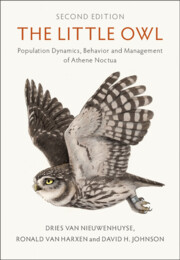Book contents
- The Little Owl
- The Little Owl
- Copyright page
- Contents
- Foreword
- Preface
- Acknowledgements
- Executive Summary
- Chapter 1 Introduction: Framework
- Chapter 2 History and Traditions
- Chapter 3 Fossil Evidence, Taxonomy and Genetics
- Chapter 4 Morphology and Body Characteristics
- Chapter 5 Distribution, Population Estimates and Trends
- Chapter 6 Habitat
- Chapter 7 Diet
- Chapter 8 Breeding Season
- Chapter 9 Behavior
- Chapter 10 Population Regulation
- Chapter 11 Management and Conservation
- Chapter 12 Research Priorities
- References
- Index
Chapter 3 - Fossil Evidence, Taxonomy and Genetics
Published online by Cambridge University Press: 29 September 2023
- The Little Owl
- The Little Owl
- Copyright page
- Contents
- Foreword
- Preface
- Acknowledgements
- Executive Summary
- Chapter 1 Introduction: Framework
- Chapter 2 History and Traditions
- Chapter 3 Fossil Evidence, Taxonomy and Genetics
- Chapter 4 Morphology and Body Characteristics
- Chapter 5 Distribution, Population Estimates and Trends
- Chapter 6 Habitat
- Chapter 7 Diet
- Chapter 8 Breeding Season
- Chapter 9 Behavior
- Chapter 10 Population Regulation
- Chapter 11 Management and Conservation
- Chapter 12 Research Priorities
- References
- Index
Summary
Different owl species and subspecies were defined in the early days of taxonomy uniquely based upon morphological features like size and color in specific geographical regions across the world. Recently, more differentiators are taken into account to define new species to avoid upgrading them from a subspecies based upon limited aspects. We consider the biological species concept that takes biological characteristics into account, morphological concept studies, especially morphometrics and coloration of the bird, the phylogenetic concept, using mitochondrial DNA studies to establish a lineage that eventually leads to a common ancestor, complemented by fossil evidence for the evolution of species. Vocalizations of Little Owls across the range are increasingly documented and taken into account as well. The last approach considers the geographical distribution and the use of validated, geocoded, high-quality photographic input. In this chapter we present the current fossil evidence for ancestors of the species. We describe the historical context in which subspecies have been defined. We illustrate the way the subspecies were described, for which we now have evidence for their relevance. We consider 14 subspecies of Little Owl for which we have found substantial evidence. This means that we have one more subspecies.
- Type
- Chapter
- Information
- The Little OwlPopulation Dynamics, Behavior and Management of <I>Athene noctua</I>, pp. 20 - 88Publisher: Cambridge University PressPrint publication year: 2023



